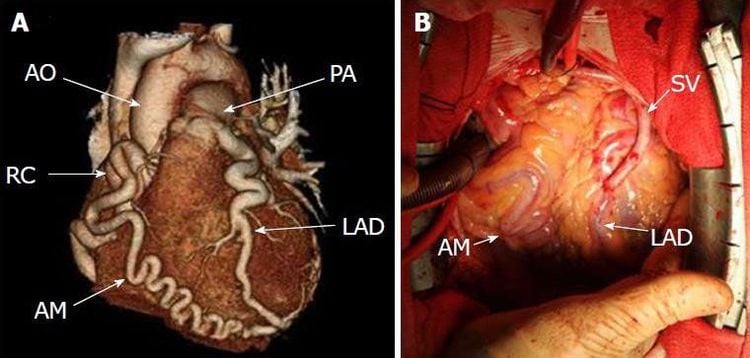This is an automatically translated article.
The article was professionally consulted with Cardiologist - Cardiovascular Center - Vinmec Central Park International General Hospital.Coronary artery malformation is a congenital defect of one or more coronary arteries. People may not know they have a coronary artery malformation until they experience symptoms such as chest pain, heart failure, or sudden, fatal cardiac arrest.
1. What is coronary artery malformation?
Like all other tissues in the body, the heart muscle needs oxygen-rich blood to function. The coronary arteries are the blood vessels that nourish the heart. The heart consists of two coronary arteries, the right coronary artery and the left coronary artery. The left coronary artery runs a short distance from 1-3 cm and then divides into two large branches, the anterior interventricular artery and the circumflex artery. Thus, the coronary artery system consists of three large branches that are the right coronary artery, the anterior interventricular artery and the circumflex artery. From these branches, there will be many small arteries that are responsible for carrying oxygen-rich blood from the aorta to nourish the structures in the heart. Because of the function of supplying blood to the heart muscle, any disorder Or coronary artery disease has the potential to reduce the flow of oxygen and nutrients to the heart, possibly leading to a heart attack or death.Coronary artery malformation is a congenital defect in one or more coronary arteries. These defects can be abnormalities in the size, shape, internal structure or position of the coronary arteries, thereby reducing blood flow to the heart causing symptoms similar to coronary artery disease.
2. Symptoms of coronary artery malformation
Depending on the abnormality of the coronary arteries, the symptoms of coronary artery malformations also vary widely. Some types of malformations have no associated symptoms and are discovered incidentally through diagnostic tests such as echocardiography (echo) or cardiac catheterization. While other types of coronary artery malformations can cause symptoms related to reduced blood flow to heart tissue, such as chest pain with exertion or at rest.Patients with coronary artery malformation may have symptoms in childhood or only in adulthood, depending on the type of coronary malformation acquired. Common symptoms in children are shortness of breath, pale skin, poor appetite, sweating, ... While the symptoms of adults are shortness of breath, fainting when exercising or doing heavy work, fatigue. fatigue, chest pain,...
Sudden cardiac arrest causing sudden death is the most dangerous complication of coronary artery malformation. Adolescents or adults may not know they have a coronary artery malformation until they experience chest pain, heart failure, or sudden, fatal cardiac arrest. Between 4 and 15% of young people who die from sudden cardiac arrest are found to have coronary artery anomalies. Coronary artery malformations are the second most common cause of sudden death in young athletes.

Người bệnh có triệu chứng đau ngực và kèm theo các triệu chứng lâm sàng khác
3. How to diagnose coronary artery malformation?
To diagnose coronary artery malformations, the doctor will perform a general examination, listen to the heart, lungs,... Depending on the patient's age and clinical condition, the doctor will assign a number of laboratory techniques. such as:Echocardiogram (echo): sound waves are used to create moving pictures of the heart and heart valves. Coronary angiography: A technique that uses a catheter to follow a large blood vessel into the heart. This is an invasive technique that helps doctors assess abnormalities, lesions and anatomical and physiological aspects of the heart and blood vessels supplying the heart. Cardiac catheterization also helps to measure hemodynamic parameters such as vascular pressure, cardiac chamber pressure, cardiac output, oxygen saturation,... Electrocardiogram: helps detect abnormal activity of the heart. heart rate and detect myocardial tension (dilation or expansion). Cardiac computed tomography (CCTA): helps provide detailed images of blood vessels. Cardiac Magnetic Resonance Angiography (CMRA): This is a magnetic resonance imaging technique that helps evaluate blood flow through the arteries of the heart.

Sự bất thường của động mạch vành trái từ động mạch phổi ở người trưởng thành
4. How to treat coronary artery malformation?
The doctor will recommend an appropriate course of treatment for coronary artery malformations based on the patient's age, health status, medical history, disease severity, and lifestyle. If the patient has mild to moderate symptoms, the doctor may prescribe medications such as beta blockers to slow the heart rate, diuretics to remove excess water from the body and reduce working capacity. Cardiac contractility, antiarrhythmic drugs that help regulate the heart rate, etc. Oxygen therapy can also be used to increase the amount of oxygen-rich blood reaching the heart.Many different surgical techniques can be performed to correct coronary artery malformations. The type of surgery will depend on the specific type of coronary artery malformation.
If you have been diagnosed with a coronary artery malformation, even though you have no symptoms, you need to have regular check-ups so that your doctor can evaluate changes in the status of your coronary arteries. Patients with coronary artery malformations need to exercise at a moderate level, avoid excessive physical exercise, and maintain a healthy diet.
To protect heart health in general and detect early signs of cardiovascular disease, customers can sign up for Cardiovascular Screening Package - Basic Cardiovascular Examination of Vinmec International General Hospital. The examination package helps to detect cardiovascular problems at the earliest through tests and modern imaging methods. The package is for all ages, genders and is especially essential for people with risk factors for cardiovascular disease.
Please dial HOTLINE for more information or register for an appointment HERE. Download MyVinmec app to make appointments faster and to manage your bookings easily.













